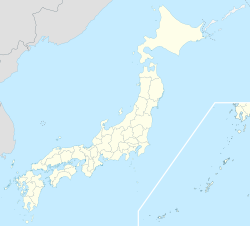Fuchū, Hiroshima (town)
In this article, Fuchū, Hiroshima (town) will be addressed from different perspectives, in order to analyze its importance, impact and relevance in various areas. Its origin, evolution and consequences will be investigated, as well as its relationship with other relevant topics. Through a multidisciplinary approach, we will seek to understand its influence on current society, as well as its possible future implications. Possible solutions, recommendations and challenges associated with Fuchū, Hiroshima (town) will also be examined, with the aim of providing a comprehensive vision and reflecting on its meaning in our current reality.
Fuchū
府中町 | |
|---|---|
 Fuchū town office | |
 Location of Fuchū in Hiroshima Prefecture | |
 | |
| Coordinates: 34°23′33″N 132°30′16″E / 34.39250°N 132.50444°E | |
| Country | Japan |
| Region | Chūgoku San'yō |
| Prefecture | Hiroshima |
| District | Aki |
| Area | |
• Total | 10.41 km2 (4.02 sq mi) |
| Population (February 1, 2024) | |
• Total | 52,597 |
| • Density | 5,100/km2 (13,000/sq mi) |
| Time zone | UTC+09:00 (JST) |
| City hall address | 3-5-1 Odori, Fuchu-cho, Aki-gun, Hiroshima-ken 735-8686 |
| Website | Official website |
| Symbols | |
| Flower | Camellia japonica |
| Tree | Camphora officinarum |


Fuchū (府中町, Fuchū-chō) is a town located in Aki District, Hiroshima Prefecture, Japan. As of 1 February 2024, the town had an estimated population of 52,597 in 23930 households and a population density of 5,100 inhabitants per square kilometre (13,000/sq mi).[1] The total area of the town is 10.41 square kilometres (4.02 sq mi).
Geography
Fuchū is located in south-central Hiroshima, at the eastern end of the Ota River delta, the southern part is flat, but the northern part is hilly. The town is completely surrounded by the city of Hiroshima.
Adjoining municipalities
Climate
Fuchū has a humid subtropical climate (Köppen climate classification Cfa) with very warm summers and cool winters. The average annual temperature in Fuchū is 14.7 °C. The average annual rainfall is 1601 mm with September as the wettest month. The temperatures are highest on average in July, at around 26.2 °C, and lowest in January, at around 3.8 °C.[2]
Demographics
Per Japanese census data,[3] the population of Fuchū has been steady for the past 30 years.
| Year | Pop. | ±% |
|---|---|---|
| 1940 | 7,257 | — |
| 1950 | 11,408 | +57.2% |
| 1960 | 17,104 | +49.9% |
| 1970 | 40,302 | +135.6% |
| 1980 | 47,817 | +18.6% |
| 1990 | 50,060 | +4.7% |
| 2000 | 50,673 | +1.2% |
| 2010 | 50,448 | −0.4% |
| Fuchu population statistics[4] | ||
History
The area of Fuchū was the center of ancient Aki Province, and the location of the Kofun period Kamiokada Kofun, Nara period Shimookada Kanga ruins and the Heian period provincial capital of the province. In the Edo Period, it was part of the holdings of Hiroshima Domain. Following the Meiji restoration, the village of Fuchū was established within Aki District, Hiroshima with the creation of the modern municipalities system on April 1, 1889. Fuchū was raised to town status on January 1, 1937.
Government
Fuchū has a mayor-council form of government with a directly elected mayor and a unicameral town council of 18 members. Fuchū contributes three members to the Hiroshima Prefectural Assembly. In terms of national politics, the town is part of the Hiroshima 4th district of the lower house of the Diet of Japan.
Economy
The main industry of Fuchū is the automobile industry, as the town has the headquarters of Mazda.[5]
Education
Fuchū has five public elementary schools and two public junior high schools operated by the town government, and one public high school operated by the Hiroshima Prefectural Board of Education.
Transportation
Railway
![]() JR West (JR West) - San'yō Main Line
JR West (JR West) - San'yō Main Line
Highways
Fuchū is not on any national highway or expressway.
Notable people from Fuchū
- Kōji Kikkawa, musician
- Tite Kubo, manga artist
- Satoshi Murayama, professional shogi player
References
- ^ "Fuchū town official statistics" (in Japanese). Japan.
- ^ Fuchū climate data
- ^ Fuchū population statistics
- ^ Fuchū population statistics
- ^ "Offices Archived 2009-10-07 at the Wayback Machine." Mazda. Retrieved on October 29, 2009.
External links
 Media related to Fuchū, Hiroshima (town) at Wikimedia Commons
Media related to Fuchū, Hiroshima (town) at Wikimedia Commons- Fuchū official website (in Japanese)


